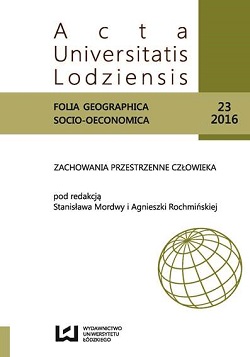Przestrzenny charakter zachowań matrymonialnych
DOI:
https://doi.org/10.18778/1508-1117.23.08Słowa kluczowe:
zachowania matrymonialne, dobór małżeński, geografia behawioralnaAbstrakt
Artykuł podejmuje problematykę aspektów przestrzennych zachowań matrymonialnych. Zachowania matrymonialne należą do tych, na które w większym stopniu wpływają czynniki behawioralne (status społeczny, wykształcenie, narodowość, religia) niż czynniki przestrzenne. Niemniej jednak, w procesie doboru małżeńskiego cechy przestrzenne przyszłego współmałżonka są istotne przy podejmowaniu decyzji, obok innych cech partnerów, takich jak cechy demograficzne i społeczne. W artykule przedstawiono wybrane podejścia teoretyczne odnoszące się do doboru małżeńskiego. Celem artykułu było także zaprezentowanie przestrzennego wymiaru doboru małżeńskiego w Polsce w różnych przekrojach: województw, jednostek miasto–wieś oraz miasta (przykład Łodzi).Bibliografia
Clark W.A., 1976, Migration in Milwaukee, „Economic Geography”, 52.
Google Scholar
DOI: https://doi.org/10.2307/142791
Comptom P.A., 1991, Is fertility in Western industrial countries amenable to geographical study?, [w:] Bähr J., Gans P. (eds.), The geographical approach to fertility, Im Selbstverlag des Geographischen Instituts der Universität Kiel, Kiel, s. 73–93.
Google Scholar
Dzieciuchowicz J., 1995, Koncepcja poznawcza zachowań migracyjnych, „Acta Universitatis Lodziensis. Folia Geographica”, 20.
Google Scholar
Giddens A., 2003, Stanowienie społeczeństwa: zarys teorii strukturacji, Zysk i S-ka, Poznań.
Google Scholar
Golledge R.G., Zannares G., 1973, Cognitive approaches to the analysis of human spatial behaviour, [w:] Ittelson W.H. (eds.), Environment and Cognition, Seminar Press, New York.
Google Scholar
Good W.J., 1964, The Family, New Jersey.
Google Scholar
Guelke L., 1981, Idealism, [w:] Harvey M.E., Holly B.P. (eds.), Themes in Geographic Thoughts, Croom Helm, London.
Google Scholar
Hägerstrand T., 1975, Time, space and human conditions, [w:] Dynamic Allcation of Urban Space, Saxon House, Farnboroug.
Google Scholar
Hollingshead A.B., 1950, Cultural Factors in the Selection of Marriage Mates, „American Sociological Review”, 15.
Google Scholar
DOI: https://doi.org/10.2307/2086915
Irwing H., 1975, Distance, intensity, kinship: key dimensions of social interaction, „Sociology and Social Research”, 60.
Google Scholar
Janiszewska A., 2007, Dobór przestrzenny i demograficzno-społeczny małżeństw zawieranych w Łodzi, Wydawnictwo UŁ, Łódź.
Google Scholar
Jędrzejczyk D., 2001, Wprowadzenie do geografii humanistycznej, Wydawnictwo UW, Warszawa.
Google Scholar
Jones R.C., 1980, The role of perception in urban in – migration: a path analytic model, „Geographical Analysis”, 12.
Google Scholar
DOI: https://doi.org/10.1111/j.1538-4632.1980.tb00021.x
Jones C., 1981, Residential mobility: an economic model, „Scottish Journal of Political Economy”, 28.
Google Scholar
DOI: https://doi.org/10.1111/j.1467-9485.1981.tb00074.x
Kałuża D., 2007, Otwartość doboru terytorialnego małżonków we współczesnej Polsce, „Roczniki Socjologii Rodziny”, 17, UAM.
Google Scholar
Kerckhoff A.C., 1971, Patterns of Homogamy in Mate Selection, [w:] Anderson M. (ed.), Sociology of the Family, London.
Google Scholar
Kuciarska-Ciesielska M., 1978, Ruchliwość przestrzenna nowożeńców, „Wiadomości Statystyczne”, 1.
Google Scholar
Lewis G.J., 1982, Human migration: a geographical perspective, Croom Helm, London.
Google Scholar
Moore G.T., Golledge R.G., 1976, Environmental knowing: concepts and theories, [w:] Moore G.T., Golledge R.G. (eds.), Environmental knowing, Dowolen Hutchinson and Ross, Stroudsburg.
Google Scholar
Mrzygłód H., 1996, Dobór małżeński w rodzinach marynarzy, Wydawnictwo Naukowe Uniwersytetu Szczecińskiego, Szczecin.
Google Scholar
Samuels M.S., 1981, An existential geography, [w:] Harvey M.E., Holly B.P. (eds.), Themes in Geographic Thought, Croom Helm, London.
Google Scholar
Shaw R.P., 1975, Migration Theory and Fact: a review and bibliography of current literature, Regional Science Research Institute, Philadelphia „Studia Demograficzne”, 57/58.
Google Scholar
Smith C.J., 1978, Self-help and social networks in the urban community, „Ekistics”, 46.
Google Scholar
Strzelecki Z., 1976, Terytorialny i społeczny dobór nowożeńców w Polsce Ludowej, „Biuletyn IGS”, 2.
Google Scholar
Strzelecki Z., 1989, Cykl życia rodziny a migracje, „Monografie i Opracowania SGPiS”, 5.
Google Scholar
Szukalski P., 2012, Wpływ kryzysów na zachowania demograficzne, „Wiadomości Statystyczne”, 4, s. 17–30.
Google Scholar
DOI: https://doi.org/10.59139/ws.2012.04.2
Thorns D.C., 1980, The role of the family life cycle in residential mobility, „Centre for Urban and Regional Studies Workshop Paper”, 69, University of Birmingham.
Google Scholar
Walmsley D.J., Lewis G.J., 1997, Geografia człowieka. Podejście behawioralne, PWN, Warszawa.
Google Scholar
Warzywoda-Kruszyńska W., 1974, Małżeństwa a struktura społeczna, Zakład Narodowy im. Ossolińskich, Wydawnictwo PAN, Wrocław–Warszawa–Kraków–Gdańsk.
Google Scholar
Weinberg D.H., 1979, The determinants of intra-urban household mobility, „Regional Science and Urban Economics”, 9.
Google Scholar
DOI: https://doi.org/10.1016/0166-0462(79)90014-0
Węcławowicz G., 2003, Geografia społeczna miast, PWN, Warszawa.
Google Scholar
Wienold H., 1972, Kontakt, Einfűhlung und Attraktion, Stuttgart.
Google Scholar
Winch R.F., 1958, Mate Selection. A study of Complementary Needs, New York.
Google Scholar
Pobrania
Opublikowane
Jak cytować
Numer
Dział
Licencja

Utwór dostępny jest na licencji Creative Commons Uznanie autorstwa – Użycie niekomercyjne – Bez utworów zależnych 4.0 Międzynarodowe.








